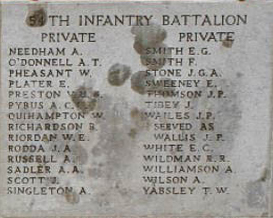Joseph SCOTT
Eyes blue, Hair brown, Complexion ruddy
Joseph Scott - A Seafaring Infantryman
Can you help us identify Joseph?
Joseph was killed in Action at Fromelles. As part of the 54th Battalion he was positioned near where the Germans collected soldiers who were later buried at Pheasant Wood. There is a chance he might be identified, but we need help. We are still searching for suitable family DNA donors, particularly looking for a male donor. To date, the number of Scott men with the same given names and born around the same time has proven too difficult to overcome to be sure of a way forward.
In 2008 a mass grave was found at Fromelles, a grave the Germans dug for 250 (Australian) bodies they recovered after the battle.
If you know anything of contacts named Scott - from South Shields, England, please contact the Fromelles Association.
See the DNA box at the end of the story for what we do know about his family.
Early Life
Joseph Scott was born 20 August 1881 in South Shields, on the south bank at the mouth of the River Tyne, England. His parents were James and Elizabeth Scott. James worked as a slipper maker / shoemaker. Joseph had an older brother and sister, William (Bill) and Jane, and a younger sister, Margaret. He did his schooling at the Baring Street Board School in South Shields.
Joseph and his brother worked as stokers for merchant ships and were living in South Shields with their mother, who had been widowed by 1911. Their sisters Jane and Margaret lived nearby. The brothers were also in the Royal Naval Reserves, with Bill awarded campaign medals for WW1 as a Merchant Seaman. Joseph’s travels led him to Australia aboard the Clan Campbell, disembarking in Sydney on 22 September 1912.
He had worked as a fireman on the crew but was discharged soon after he arrived. In his enlistment papers he stated he was a coal ‘lumper’ - essential workers for the steam driven ships - loading coal and working as general wharf labourers. He was probably VERY fit.
Off to War - Egypt
At age 33, Joseph enlisted at Warwick Farm, outside Sydney, in September 1915 and was assigned to the 2nd Battalion, 15th Reinforcements. During his military training at Liverpool Camp, he wrote to his sister Meggie, with an optimistic outlook for his safety (note - some minor editing for emphasis). He must have had a close-knit and loving family.
Dear Sister,
I now take the pleasure of writing you these few lines hoping to find you and your family well as this leaves me at present.
Dear Sister we are leaving here for sure on the eight of this month for some where but I expect it will be Egypt but there is none of us knows anything. It will take us about 5 weeks to do the journey in so if you write when you receive this letter I will receive it on landing.
Dear Sister I will not be sorry when we are away from here as I have been in Camp six months now and I am getting sick of it I think a little excitement will do the lot of us good.
You want to take notice of this address as I have made my will out to you as my next of kin but if the worst should happen then you can share it with my brother Bill but I don’t think there will be much need for I think I will be home at the finish and have a good time with it myself. I hope you received the Photo alright and mind you take care of my dog.
Dear Sister you can tell little John that I will bring him a Turkish cap and some Turkish delight.
Dear Sister, I am leaving Mrs Lillies 3s. a day for to put in the Bank for me so when I come back I should have a nice little cheque to my credit.
I don’t think I have anything more to say at present only give my best respects to all inquiring friends so no more at present
from your loving brother Joseph Scott.
This letter was later certified to be a true copy of Joseph’s Will. Joseph did leave Australia on the 8th and he arrived in Suez on 9 April. Prior to his arrival, major reorganizations had been underway following the heavy losses at Gallipoli and the thousands of new recruits streaming in from Australia.
The 54th Battalion had been formed in mid-February and Joseph was reassigned to this battalion soon after he had landed, joining them while they were at Ferry Post continuing their training and guarding the Suez Canal. He spent all of May at the front line trenches in Katoomba Heights, 8 miles from the Suez Canal.
Fromelles
The call to the Western Front to join with the British Expeditionary Force came on 20 June and the 982 soldiers of the 54th Battalion left Egypt. They sailed on the Caledonian for the 10-day trip to Marseilles via Malta. After disembarking in France, there was a three-day train trip to Hazebrouck, 30 km west of Fleurbaix. By 2 July the Battalion was billeted in barns, stables and private houses in nearby Thiennes for a week. Training now included the use of gas masks and exposure to the effects of the artillery shelling. It was hoped that these tests would “inspire the men with great confidence”.
Source AWM4 23/71/6 54th Bn War Diaries July 1916 page 2
On 10 July they moved to Sailly sur la Lys and on the 11th they were into the trenches in Fleurbaix. The health and spirit of the troops was reported as good. After a few days getting exposed to the trenches, they moved back to billets in Bac-St-Maur. Major Roy Harrison wrote home on July 15th. With his Gallipoli experience, the tone in this letter was certainly circumspect for the upcoming battle.
“The men don’t know yet what is before them, but some suspect that there is something in the wind. It is a most pitiful thing to see them all, going about, happy and ignorant of the fact, that a matter of hours will see many of them dead; but as the French say ‘C’est la guerre’.”
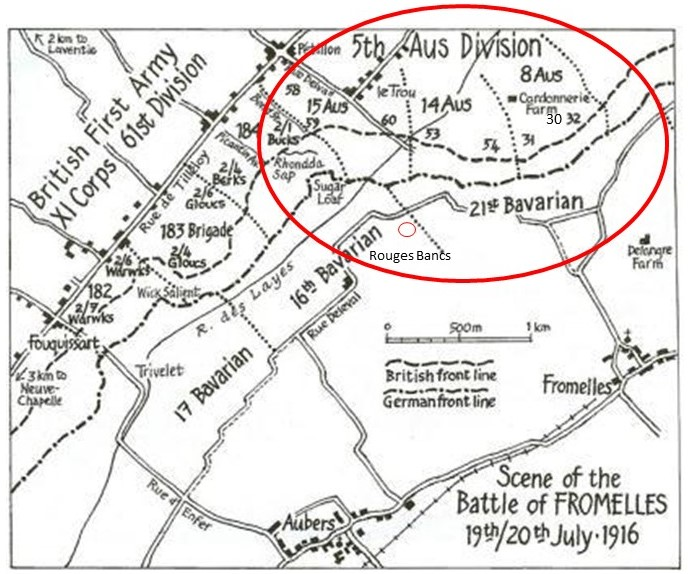
An attack was planned on the 17th, but it was delayed due to the weather. The weather soon improved and by 2.00 PM on 19 July Joseph was in back in the trenches, ready for the Germans. The main objective for the 54th was to take the trenches to the left of a heavily armed, elevated German defensive position, the ‘Sugar Loaf’, which dominated the front lines. If the Sugar Loaf could not be taken, the 54th and the other battalions would be subjected to murderous enfiled fire from the machine guns and counterattacks from that direction. As they advanced, they were to link up with the 31st and 53rd Battalions.
The attack began at 5.50 PM. They moved forward in four waves – half of Joseph’s A Company and B Company in each of the first two waves and half of C & D in the third and fourth. The first waves did not immediately charge the German lines, they went out into No-Man’s-Land and lay down, waiting for the British bombardment to lift. At 6 PM, the German lines were rushed. The 54th were under heavy artillery, machine gun and rifle fire, but were able to advance rapidly. The 14th Brigade War Diary notes that the artillery had been successful and “very few living Germans were found in the first and second line trenches”.
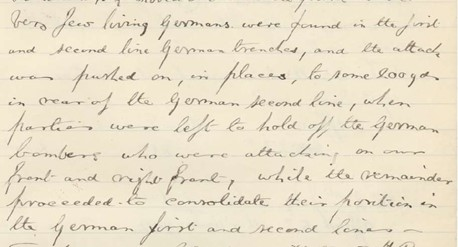
Some of the advanced trenches were just water filled ditches which needed to be fortified to be able to hold their advanced position against future attacks. There was heavy artillery, machine gun and rifle fire, but they were able to advance and link up with the 53rd on their right and, with the 31st and 32nd, occupy a line from Rouges Bancs to near Delangre Farm. However, the 60th on their far right had been unable to advance due to the devastation from the machine gun emplacement at the Sugar Loaf, leaving this flank exposed.
As the battle raged on, reinforcements and supplies were key needs for support the fighting, but Lieutenant Harris also noted the importance of ‘creature comforts’ for morale.
They held their lines through the night. However, with heavy losses and the German counterattacks, the Australians were eventually forced to retreat. This was complicated by the fact that the exposed right flank of the 54th had allowed the Germans access to the first line trench BEHIND the 54th/53rd and the German advances in the trench had to repelled as they retreated. By 7.30 AM on the 20th the 54th were pulled all the way back to Bac-St-Maur, 5 km from the front.
In this very short period of time, of the 982 soldiers of the 54th that left Egypt, initial roll call counts were: 73 killed, 288 wounded and 173 missing. To get some perspective of the battle, when Charles Bean, Australia’s official war historian, attended the battlefield two and half years later, he observed a large amount of bones, torn uniforms and Australian kit still on the battlefield. Ultimately, 173 soldiers from the 54th were killed in action or died from their wounds. Of this, 102 were missing.
After the Battle
Joseph did not survive the battle and was among the missing after roll call on the 20th. There was a great deal of confusion in reconciling what happened to Joseph. The Red Cross reports in his file either cite him as John or cite his regimental number as 4872 instead of 4873.
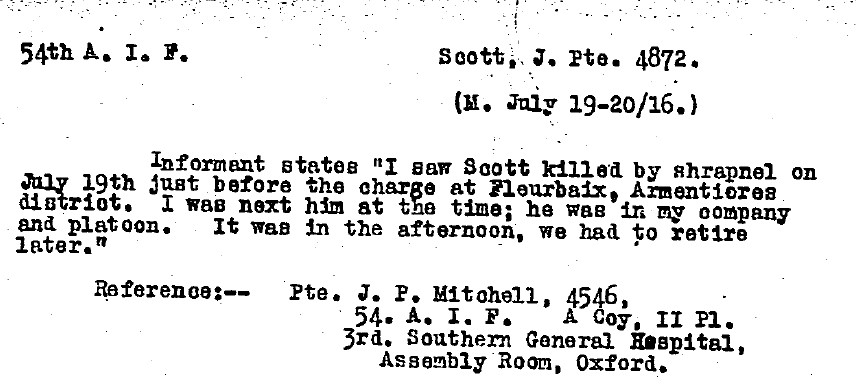
The report in Joseph’s file about being buried by Chaplain, Captain W. H. Holliday also carries the wrong number.
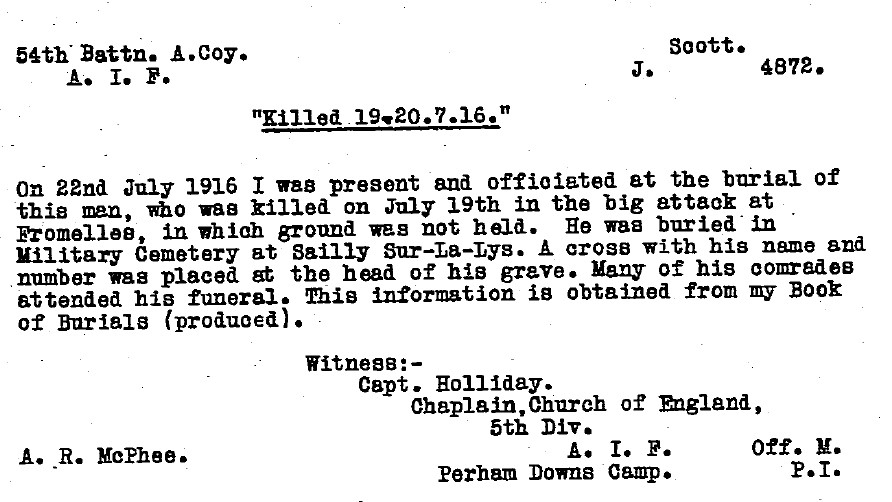
4872 is the number of the 54th Battalion’s Private Francis Patrick Scally’s number, who was killed and IS buried at the Sailly-Sur-La-Lyes Military Ceremony. The most definitive, and most likely, outcome is that Joseph was in the advanced area of the attack when he was killed. His ID tags were recovered by the Germans and he was reported as “in Gegend Fromelles gefallen” (fell in the area of Fromelles).
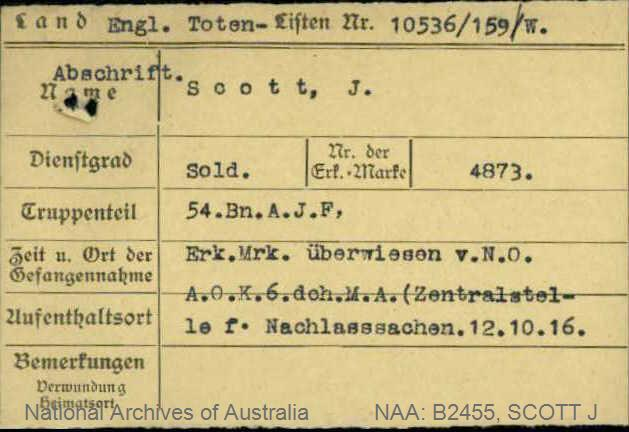
He was formally declared as having been Killed in Action by an ‘enquiry in the field’ held at the end of March 1917. Joseph was awarded the British War Medal, the Victory Medal, a Memorial Plaque and a Memorial Scroll. He is commemorated at V.C. Corner (Panel No 11), Australian Cemetery Memorial, Fromelles, France.
His personal belongings were returned to his sister Margaret in South Shields. He never got to bring his nephew John a Turkish cap or Turkish delights.
###Could Joseph Still Be Found?
Joseph has no known grave. After the battle, German soldiers removed 250 Australian casualties from battlefield, burying them in large pits near Pheasant Wood. This mass grave was not discovered until 2008. As of 2024, 180 of the 250 soldiers who were in the grave have been able to be identified by DNA matching from family members. Joseph was fighting in this area and, so far, 28 of the 102 unidentified soldiers from the 54th have been found to be in the grave.
Joseph may be one of the 70 remaining soldiers in the grave who are not yet identified. We need to find family members to contribute DNA samples to find out, particularly a male donor. To date, the number of Scott men with the same given names and born around the same time has proven too difficult to overcome to be sure of a way forward. If you know anything of contacts here in Australia or his relatives in England, please contact the Fromelles Association.
DNA samples are being sought for family connections to
| Soldier | Joseph Scott (1881-1916) born Newcastle Upon Tyne |
| Parents James Scott (1843-1897) born Holyburn Glasgow, died Durham England and Elizabeth/Eliza Richardson (b 1854) Winlaton, Durham, England. Died 1914, South Shields, Durham |
| Siblings | William (1873- ) b Newcastle upon Tyne | ||
| Jane Elizabeth (1880-1961) b South Shields, m Henry Bohill, 10 children | |||
| Margaret A (1886-1952) b South Shields, Newcastle upon Tyne, m John Edward Mordue, Newcastle upon Tyne, 3 children |
| Grandparents | |||
| Paternal | Grandfather SCOTT unknown and Grandmother Elizabeth (Died 1914, South Shields, Dunham) | ||
| Maternal | Grandfather Name unknown and Grandmother Jane |
Seeking DNA Donors

Contacts
(Contact: carla@fromelles.info or geoffrey@fromelles.info).
(Contact: army.uwc@defence.gov.au or phone 1800 019 090).
Donations
If you are able, please contribute to the upkeep of this resource.
(Contact: bill@fromelles.info ).


